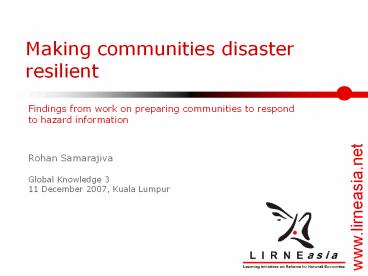Making communities disaster resilient PowerPoint PPT Presentation
Title: Making communities disaster resilient
1
Making communities disaster resilient
Findings from work on preparing communities to
respond to hazard information
- Rohan Samarajiva
- Global Knowledge 3
- 11 December 2007, Kuala Lumpur
2
Agenda
- Why this approach?
- ICTs in disaster-risk reduction
- Supplementing government action on public warning
- Better prepared to receive warnings and act
- Fit with Sarvodayas grama swarajya (village
self-governance) philosophy - Parallels between the classic public-warning
model and the community-based hazard information
model - Early warning center -- Hazard information hub
- Communication to first responders communication
to community leaders - Last mile
- Closed system useful for testing improvements to
elements of public warning chain
3
Cyclone Sidr
4
Why declining deaths?
Year Cyclone Strength Deaths
1970 Bhola Category 3 300-500,000
197021 Gorky Category 4 138,000
197037 Sidr Category 4 3,447
5
Completing the chain Warning training at the
last mile
- Bangladesh reduced casualties (but not damage to
property livelihoods) through - Communicating cyclone warnings to villages
through HF radios and trained volunteers - Easy-to-understand flag system at the last mile
- Cyclone shelters
- People who trust the warnings and evacuate
- Deaths from Sidr would have been less, if not
for false tsunami warning and evacuation one
month earlier (September 12th, 2007)
6
Cyclones tsunamis
- Both affect the Bay of Bengal
- Tsunamigenic earthquakes in Sunda Trench every
year since 2004 - Difference is lead time
- 2-3 days for cyclones
- 90 mts to 6 hours for Bay of Bengal countries
other than Indonesia - Simply replicating Bangladesh is not enough
- Bangladesh model used 1990s communication
technology - Much has happened since
7
Physical and symbolic worlds, absent linking
technologies
Mediated interpersonal
Physical world where hazards occur
Symbolic world where action originates
8
The physical, the symbolic their linking
through ICTs, simplified
Physical world where hazards occur
Warnings (telecom media)
Mediated interpersonal
TV, Radio Cell broadcasts
Symbolic world where action originates
Warnings (telecom)
More time to run more lives saved
9
Early warning chain (standard form)
10
Early warning chain (community based applicable
to Last-Mile HazInfo project)
Emergency Response Plan coordinator
Media Govt 1st Responders
From domestic international sources
SCDMC will never issue warnings only alerts so
that communities can be better prepared to
receive the warning from government
11
ICTs for reaching community leaders
12
Which work best?
- Eight modes (individual and combined) tested
- Reliability and effectiveness (composite
measures) - Complementary redundancy
13
Community
- Forms of training that will work
- Levels of organizational strength
- Importance of emergency response plans
- Plan without simulation is no plan
- Simulation without plan cannot be done
14
Way forward
- Disseminate lessons to improve public warning
systems - More trials in specific contexts if needed
- Improve community based response
- In Sri Lanka, 1,000 Sarvodaya villages ? 15,000
Sarvodaya villages ? 30,000 villages - Develop sustainable public-private models of
sustaining community training and dissemination
of hazard information - Improve multi-lingual, multi-modal Common
Alerting Protocol (CAP)

